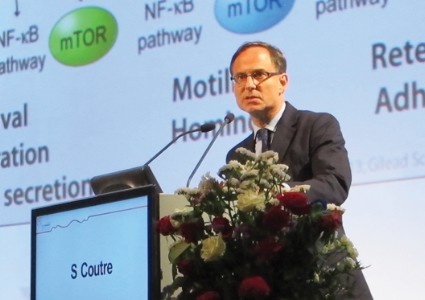User login
MILAN – The benefits of combining idelalisib with rituximab remained unchanged in heavily pretreated, relapsed chronic lymphocytic leukemia unsuitable for chemotherapy in the second interim analysis of a phase III trial and extension study.
With 63% of events reported in Study 116, the primary endpoint of progression-free survival was 5.5 months with rituximab (Rituxan) plus placebo and had not been reached with rituximab and idelalisib.
These data were identical to those observed in the first interim analysis, save for an almost imperceptible shift in the hazard ratio from 0.15 to 0.18, with the same P value of less than .0001.
In the poor-prognosis subsets of patients with the 17p deletion and/or TP53 mutations or unmutated immunoglobulin heavy chain variable disease, median progression-free survival had also yet to be reached with the combination, compared with medians of 4.0 months (HR, 0.16) and 5.5 months (HR, 0.14) with single-agent rituximab, Dr. Steven Coutre said at the annual congress of the European Hematology Association.
As previously reported by this publication, Study 116 was stopped early after the first interim analysis and 50% of events reported due to overwhelming efficacy. The results also prompted the Food & Drug Administration to grant idelalisib, an oral phosphoinositide 3–kinase-delta inhibitor, breakthrough therapy designation for relapsed chronic lymphocytic leukemia (CLL).
In the second interim analysis, the addition of idelalisib to rituximab significantly increased the overall response rate from 15% to 77% (Odds ratio 17.3; P less than .0001) and number of patients achieving at least a 50% reduction in lymph nodes from 6% to 92% (OR, 165.5; P less than .0001), said Dr. Coutre, professor of medicine at Stanford (Calif.) University.
Median overall survival had yet to be reached at 18 months follow-up, but was significantly longer in the idelalisib arm (HR, 0.28; P = .003).
Adverse events were quite common in either arm, but "importantly, the combination demonstrated an acceptable and manageable safety profile," he said.
As previously seen, diarrhea, colitis, and grade 3/4 transaminase elevations were more common with idelalisib, but infusion site reactions were less frequent.
The 110 patients in the idelalisib arm, as compared with 108 controls, had more grade 3 or higher adverse events (AEs)(64% and 52%) and serious AEs (49% and 38%), but fewer AEs leading to treatment discontinuation (10% vs. 12%) or death (3% vs. 11%).
During a discussion of the results, the issue of the study’s comparator arm was raised once again. Dr. Coutre observed that while he is not a "big fan of single-agent rituximab" because "it is not particularly effective, certainly not in targeting the bone marrow, the reality in the United States is that it is probably the single most used regimen in this population ... so I think it is a very valid comparison."
Recruitment is currently underway for a phase II study, the first to evaluate idelalisib alone or combined with rituximab in untreated CLL and small lymphocytic lymphoma. Idelalisib has shown single-agent activity in relapsed or refractory CLL or small lymphocytic lymphoma, but Dr. Coutre said in an interview that "It is premature to consider idelalisib for front-line therapy. There are ongoing trials for this indication."
The study was supported by Gilead Sciences. Dr. Coutre reported personal fees from Gilead for a 1-day advisory board.
MILAN – The benefits of combining idelalisib with rituximab remained unchanged in heavily pretreated, relapsed chronic lymphocytic leukemia unsuitable for chemotherapy in the second interim analysis of a phase III trial and extension study.
With 63% of events reported in Study 116, the primary endpoint of progression-free survival was 5.5 months with rituximab (Rituxan) plus placebo and had not been reached with rituximab and idelalisib.
These data were identical to those observed in the first interim analysis, save for an almost imperceptible shift in the hazard ratio from 0.15 to 0.18, with the same P value of less than .0001.
In the poor-prognosis subsets of patients with the 17p deletion and/or TP53 mutations or unmutated immunoglobulin heavy chain variable disease, median progression-free survival had also yet to be reached with the combination, compared with medians of 4.0 months (HR, 0.16) and 5.5 months (HR, 0.14) with single-agent rituximab, Dr. Steven Coutre said at the annual congress of the European Hematology Association.
As previously reported by this publication, Study 116 was stopped early after the first interim analysis and 50% of events reported due to overwhelming efficacy. The results also prompted the Food & Drug Administration to grant idelalisib, an oral phosphoinositide 3–kinase-delta inhibitor, breakthrough therapy designation for relapsed chronic lymphocytic leukemia (CLL).
In the second interim analysis, the addition of idelalisib to rituximab significantly increased the overall response rate from 15% to 77% (Odds ratio 17.3; P less than .0001) and number of patients achieving at least a 50% reduction in lymph nodes from 6% to 92% (OR, 165.5; P less than .0001), said Dr. Coutre, professor of medicine at Stanford (Calif.) University.
Median overall survival had yet to be reached at 18 months follow-up, but was significantly longer in the idelalisib arm (HR, 0.28; P = .003).
Adverse events were quite common in either arm, but "importantly, the combination demonstrated an acceptable and manageable safety profile," he said.
As previously seen, diarrhea, colitis, and grade 3/4 transaminase elevations were more common with idelalisib, but infusion site reactions were less frequent.
The 110 patients in the idelalisib arm, as compared with 108 controls, had more grade 3 or higher adverse events (AEs)(64% and 52%) and serious AEs (49% and 38%), but fewer AEs leading to treatment discontinuation (10% vs. 12%) or death (3% vs. 11%).
During a discussion of the results, the issue of the study’s comparator arm was raised once again. Dr. Coutre observed that while he is not a "big fan of single-agent rituximab" because "it is not particularly effective, certainly not in targeting the bone marrow, the reality in the United States is that it is probably the single most used regimen in this population ... so I think it is a very valid comparison."
Recruitment is currently underway for a phase II study, the first to evaluate idelalisib alone or combined with rituximab in untreated CLL and small lymphocytic lymphoma. Idelalisib has shown single-agent activity in relapsed or refractory CLL or small lymphocytic lymphoma, but Dr. Coutre said in an interview that "It is premature to consider idelalisib for front-line therapy. There are ongoing trials for this indication."
The study was supported by Gilead Sciences. Dr. Coutre reported personal fees from Gilead for a 1-day advisory board.
MILAN – The benefits of combining idelalisib with rituximab remained unchanged in heavily pretreated, relapsed chronic lymphocytic leukemia unsuitable for chemotherapy in the second interim analysis of a phase III trial and extension study.
With 63% of events reported in Study 116, the primary endpoint of progression-free survival was 5.5 months with rituximab (Rituxan) plus placebo and had not been reached with rituximab and idelalisib.
These data were identical to those observed in the first interim analysis, save for an almost imperceptible shift in the hazard ratio from 0.15 to 0.18, with the same P value of less than .0001.
In the poor-prognosis subsets of patients with the 17p deletion and/or TP53 mutations or unmutated immunoglobulin heavy chain variable disease, median progression-free survival had also yet to be reached with the combination, compared with medians of 4.0 months (HR, 0.16) and 5.5 months (HR, 0.14) with single-agent rituximab, Dr. Steven Coutre said at the annual congress of the European Hematology Association.
As previously reported by this publication, Study 116 was stopped early after the first interim analysis and 50% of events reported due to overwhelming efficacy. The results also prompted the Food & Drug Administration to grant idelalisib, an oral phosphoinositide 3–kinase-delta inhibitor, breakthrough therapy designation for relapsed chronic lymphocytic leukemia (CLL).
In the second interim analysis, the addition of idelalisib to rituximab significantly increased the overall response rate from 15% to 77% (Odds ratio 17.3; P less than .0001) and number of patients achieving at least a 50% reduction in lymph nodes from 6% to 92% (OR, 165.5; P less than .0001), said Dr. Coutre, professor of medicine at Stanford (Calif.) University.
Median overall survival had yet to be reached at 18 months follow-up, but was significantly longer in the idelalisib arm (HR, 0.28; P = .003).
Adverse events were quite common in either arm, but "importantly, the combination demonstrated an acceptable and manageable safety profile," he said.
As previously seen, diarrhea, colitis, and grade 3/4 transaminase elevations were more common with idelalisib, but infusion site reactions were less frequent.
The 110 patients in the idelalisib arm, as compared with 108 controls, had more grade 3 or higher adverse events (AEs)(64% and 52%) and serious AEs (49% and 38%), but fewer AEs leading to treatment discontinuation (10% vs. 12%) or death (3% vs. 11%).
During a discussion of the results, the issue of the study’s comparator arm was raised once again. Dr. Coutre observed that while he is not a "big fan of single-agent rituximab" because "it is not particularly effective, certainly not in targeting the bone marrow, the reality in the United States is that it is probably the single most used regimen in this population ... so I think it is a very valid comparison."
Recruitment is currently underway for a phase II study, the first to evaluate idelalisib alone or combined with rituximab in untreated CLL and small lymphocytic lymphoma. Idelalisib has shown single-agent activity in relapsed or refractory CLL or small lymphocytic lymphoma, but Dr. Coutre said in an interview that "It is premature to consider idelalisib for front-line therapy. There are ongoing trials for this indication."
The study was supported by Gilead Sciences. Dr. Coutre reported personal fees from Gilead for a 1-day advisory board.
AT THE EHA CONGRESS
Major finding: Idelalisib and rituximab significantly increased progression-free survival (HR, 0.18; P less than .0001).
Data source: A prospective phase III study in 220 patients with relapsed CLL.
Key clinical point: Adding idelalisib to rituximab improves overall response rate, progression-free survival, and overall survival in heavily pretreated relapsed CLL.
Disclosures: The study was supported by Gilead Sciences. Dr. Coutre reported personal fees from Gilead for a 1-day advisory board.

